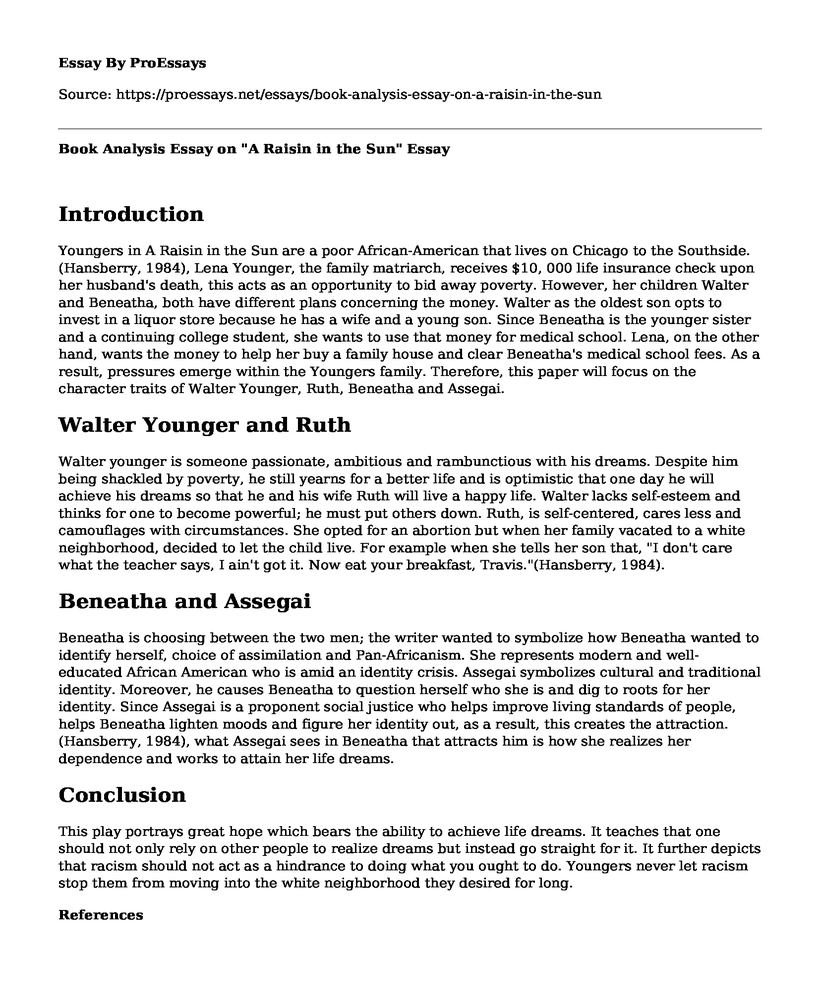Introduction
Youngers in A Raisin in the Sun are a poor African-American that lives on Chicago to the Southside. (Hansberry, 1984), Lena Younger, the family matriarch, receives $10, 000 life insurance check upon her husband's death, this acts as an opportunity to bid away poverty. However, her children Walter and Beneatha, both have different plans concerning the money. Walter as the oldest son opts to invest in a liquor store because he has a wife and a young son. Since Beneatha is the younger sister and a continuing college student, she wants to use that money for medical school. Lena, on the other hand, wants the money to help her buy a family house and clear Beneatha's medical school fees. As a result, pressures emerge within the Youngers family. Therefore, this paper will focus on the character traits of Walter Younger, Ruth, Beneatha and Assegai.
Walter Younger and Ruth
Walter younger is someone passionate, ambitious and rambunctious with his dreams. Despite him being shackled by poverty, he still yearns for a better life and is optimistic that one day he will achieve his dreams so that he and his wife Ruth will live a happy life. Walter lacks self-esteem and thinks for one to become powerful; he must put others down. Ruth, is self-centered, cares less and camouflages with circumstances. She opted for an abortion but when her family vacated to a white neighborhood, decided to let the child live. For example when she tells her son that, "I don't care what the teacher says, I ain't got it. Now eat your breakfast, Travis."(Hansberry, 1984).
Beneatha and Assegai
Beneatha is choosing between the two men; the writer wanted to symbolize how Beneatha wanted to identify herself, choice of assimilation and Pan-Africanism. She represents modern and well-educated African American who is amid an identity crisis. Assegai symbolizes cultural and traditional identity. Moreover, he causes Beneatha to question herself who she is and dig to roots for her identity. Since Assegai is a proponent social justice who helps improve living standards of people, helps Beneatha lighten moods and figure her identity out, as a result, this creates the attraction. (Hansberry, 1984), what Assegai sees in Beneatha that attracts him is how she realizes her dependence and works to attain her life dreams.
Conclusion
This play portrays great hope which bears the ability to achieve life dreams. It teaches that one should not only rely on other people to realize dreams but instead go straight for it. It further depicts that racism should not act as a hindrance to doing what you ought to do. Youngers never let racism stop them from moving into the white neighborhood they desired for long.
References
Hansberry, L. (1984). Lorraine Hansberry's A Raisin in the Sun. Samuel French, Inc. Retrieved on 22nd March 2019 fromhttp://khdzamlit.weebly.com/uploads/1/1/2/6/11261956/a_raisin_in_the_sun_-_lorraine_hansberry.pdf
Cite this page
Book Analysis Essay on "A Raisin in the Sun". (2022, Dec 16). Retrieved from https://proessays.net/essays/book-analysis-essay-on-a-raisin-in-the-sun
If you are the original author of this essay and no longer wish to have it published on the ProEssays website, please click below to request its removal:
- Billy Bishop Goes to War
- Catherine As Seen by Ellen Dean and Edgar Linton: A Contrastive Analysis
- Literary Analysis Essay on Farewell to Arms by Ernest Hemingway
- Paper Example on Common Themes in Everyday Use by Alice Walker and Hamlet by William Shakespeare
- Essay Sample on Dramatic Irony
- The Use of Symbolism in Fahrenheit 451 Essay
- Essay Example on Achilles: A Significant Contributor to World Literary History







